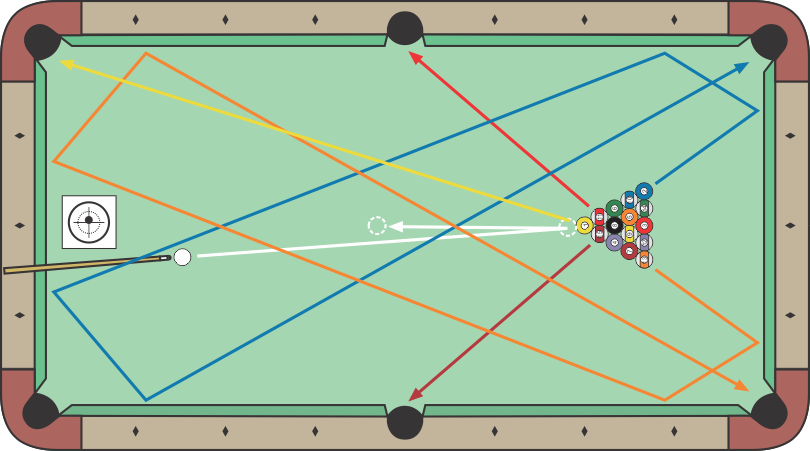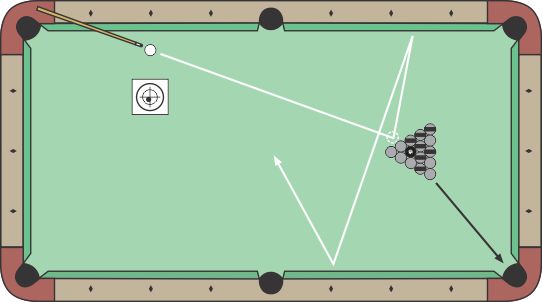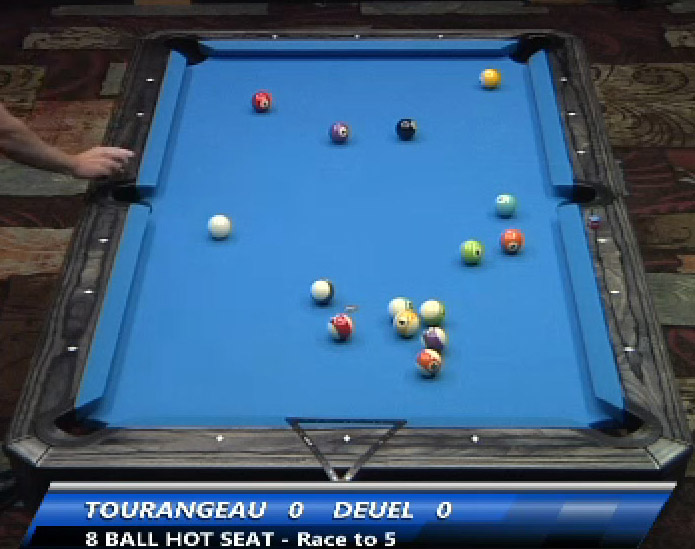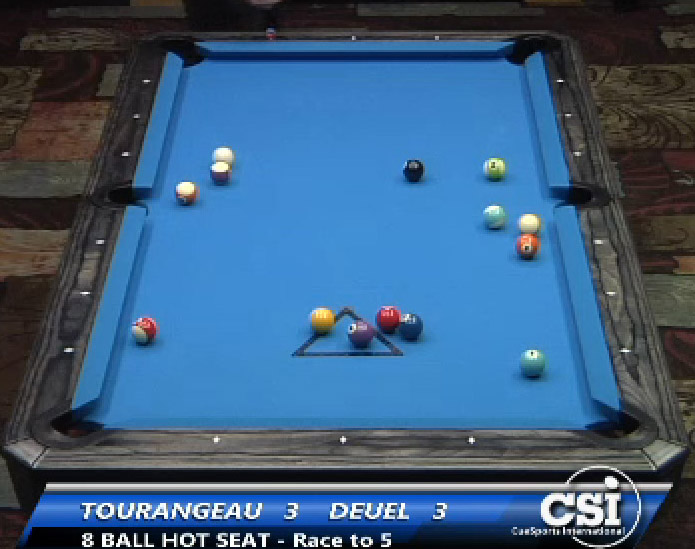What are possible strategies for breaking in 8-ball?
Vol. IV of the Video Encyclopedia of Eight Ball (VEEB) covers this topic if great detail. The following videos also provide a good overview:
Most importantly, follow the advice in the break technique section.
As shown below, a good power option for the 8-ball break is to position the CB slightly off center, and hit the lead ball squarely. As with the 10-ball break, the 2nd-row balls tend to head toward the side pockets, and the corner balls can go four rails to the corners. Positioning the CB slightly off center gives a better change for at least one of the 2nd-row balls to find a side since the balls will be coming out at slightly different speeds (reducing the chances for both being kissed off line by other balls) and slightly different angles (allowing one to still go if you don’t hit the 1 ball squarely). The off-center position also gives the 1-ball a chance to go in the upper corner.

An alternative to hitting the lead ball on the break is hitting the 2nd-ball or 3rd-ball squarely instead by breaking from the side rail. These breaks can be very effective, assuming they are allowed under the rules by which you play (e.g., APA rules prohibit a 3rd-ball break). These breaks spread the balls well and often result in pocketing a ball. It is also easier to control the CB since less power is required. Here are some examples, the first video being from Vol. IV of the Video Encyclopedia of Eight Ball (VEEB):
As shown below, the main advantage of the 2nd-ball break, especially on a “bar box,” is it will often send the far corner ball to the corner pocket (assuming the balls are not too old, and rack well, and sit well on the cloth). It also has the benefit of causing 8-ball motion, giving you a chance to pocket it on the break (often in the opposite side pocket), which awards a win under some rules (e.g., the APA league system). Clips HSV 7.8-7.11 show some examples of 8-ball motion. The far 2nd-row ball also has a tendency to bank cross side with some equipment and racks. Not all leagues and tournaments award a game victory for making the 8-ball on the break; but if they do, it is wise to try to increase your chances for pocketing the 8-ball.

Whether you use a touch of backspin or sidespin depends on how square you hit the 2nd ball. If you hit the ball fairly squarely, you can use stun (no to or bottom spin), with no sidespin, to send the CB straight across the table back into the rack area. This gives the best chance to not scratch, to break out any balls remaining in the rack area, and to get a shot after the break (usually on the bottom half of the table). You should aim to just miss the top ball (the 1 above); but if you have trouble visualizing this consistently, you can aim at the point where the 8 touches the ball beside it (the 6 above), or you can aim at the center ball in the back row (the 3 above). All three aims are very similar, so use the one that is the most consistent for you.
One disadvantage with a 2nd-ball break is sometimes the balls tend to cluster on the breaking side of the table (especially on a “bar box” where balls are more likely to cluster anyway with the small size of the table). This can also be an advantage if you don’t pocket a ball on a break (which tends to happen more with a poor rack or break), making it more difficult for your opponent to run out. Another disadvantage with a 2nd-ball break is that not as much CB speed can be used since the hit cannot be as square as with a lead-ball break; therefore, less energy will be transferred from the CB to the racked balls. Also, because the 2nd-ball break is hit from the side rail (where the cue will be a little more elevated or non-level) and since the CB hits the 2nd ball at a slight angle, not as much CB speed can be used as with a lead-ball break; otherwise, the CB will hop and can bounce off the table (which is a foul).
For more information, see “VEEB – Part VIII: The Break” (BD, June, 2016).
An alternative break, useful when the balls are not racking tightly, is a power break from the side, where the main goal is to attempt to pocket the head ball in the opposite side pocket. Here are some examples:
If pattern racking is not prohibited, you might want to use the Corey Deuel approach (see more info in the answer to the next question below), where you rack the balls in the following pattern and use a 2nd-ball break to make the solids spread up table (to make them easy for you to run out), with the stripes remaining clustered in the rack area (making them difficult for your opponent to run out):

Here are some example breaks using this pattern-racking cheat, along with some ball-gap tricks:
It is helpful to know racking and breaking strategy, but it is just as important to know how to get a tight rack.
Here are some statistics for effectiveness of pro 8-ball breaks. Some additional data is available here: “8-Ball Break Stats” (BD, August, 2016).
Here are examples of great breaks by pros:
And here are some more:
- 7 balls made on the break by Billy Thorpe
- 7 balls made on the break by Pete Heard
- 6 balls made on the break by Shane Van Boening
from Kerry McAuliffe Facebook message:
While a square hit on the 2nd ball can be effective, it is not the only effective method. Cutting the 2nd ball up to even a 1/2 ball hit can work extremely well. This will require a decent amount of draw and possibly a bit of outside. For Valley 7′ tables (and really any table but especially the Valleys), if I am breaking from the right side rail, I aim the 2nd ball about a ball past the left diamond on the end rail. I make the 8 a LOT! Also in the diagram at the bottom, I definitely do not want the cue ball going back into the rack area on the 2nd ball break. I’d prefer to come out more near center table.
Should I put balls in certain positions when I am racking for 8-ball?
Pattern racking, where you purposefully place balls in certain positions in the rack, is prohibited by the official rules of pool. But if you play under rules that allow such a thing, the pattern used by Corey Deuel below can be effective, especially when using a racking template.
from CreeDo (in AZB post):
Interesting pattern Corey has come up with for 8b. It not only ensures an even spread for his chosen group, it leaves an ugly cluster for the opponent’s group.
He breaks from the corner, hitting the 2nd row ball squarely, maybe 15-17 mph.
In the diagram it’s the stripes that spread and the solids that cluster.

This is what he was left after the break on his own racks. You can see what’s happening near the right side of the rack area. Not hard to guess which group he chose in each example.



Here are video examples of the approach:
Dr. Dave keeps this site commercial free, with no ads. If you appreciate the free resources, please consider making a one-time or monthly donation to show your support:
